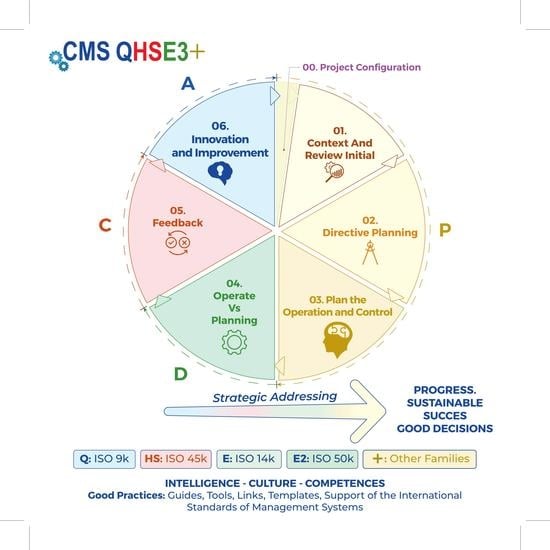ISO 50001: 2018 and Its Application in a Comprehensive Management System with an Energy-Performance Focus
Abstract
:1. Introduction
2. Material and Methods
2.1. Revision of ISO 50001: 2018
2.1.1. Regarding the Initial Chapters
2.1.2. Requirements Related to “Planning Management” (“P” Chapters of the PDCA Cycle)
2.1.3. Requirements of Chapter 8 (Management of the “Making” or “To Do” Part of the PDCA Cycle)
- Axis of analysis of the process components (workers, materials, methods, machinery, measurement, and environment) versus the risks and controls related to energy efficiency;
- Axis of process design, with particular emphasis on services, sources, uses, generation, distribution, measurement, and control of energy efficiency;
- Axis of energy-efficiency management associated with the purchase of services, equipment, and products. In this form of management, an organization interacts with suppliers, contractors, or allies that develop activities for, or on behalf of, the organization.
2.1.4. Requirements of Chapter 9 (“Check” (C) Part of the PDCA Cycle)
2.1.5. Requirements of Chapter 10 (Correction, Maintenance, and Improvement Actions of PDCA)
- The development of energy-saving actions in R/O ([26]);
- The analysis of MMAE results and the general performance, which should fulfil the objectives and goals of the EnMS;
- Analysis of the external and internal factors of the context;
- Output of feedback mechanisms such as audits and the EnMS review;
- The progress and effectiveness of actions related to corrections, responses to incidents and complaints, requirements, breaches, and corrective actions.
2.1.6. Changes to Annex A
2.1.7. Key Aspects Not Included in ISO 50001:2018
- In the introductory chapters, a structural map of the standards of the ISO 50000 family would reinforce the overview and the fundamental purpose of standard ISO 50001:2018. Another section outlining the principles of integral management and sustainability, similar to the guide contained in ISO 31000: 2018, would also be helpful.
- The context study should include a strategic and comprehensive analysis that considers the market, business, interest groups, and the geopolitics of energy.
- The annexes could present the risk management and opportunities of energy efficiency (E2) from an integral and strategic point of view, including the planning and control of product lines, process design, projects, and business approaches.
- The effective operation of the EnMS demands the coordinated deployment of strategic, tactical and operational levels that align the business culture with sustainable success.
- A strategic management approach for studying scenarios and trends should be included. This should account for the volatility of the macroeconomic and geopolitical conditions [31].
- The vision that the organization wishes to build must be correlated with the strategy of efficiency and energy saving, and with the organization’s survival in the market. This correlation must be explicitly defined and well disseminated.
- The awareness-related requirements should highlight the importance of the organization’s staff understanding the challenges of energy efficiency, knowing their roles in relation to the objectives, and knowing the approach of the programs that support energy management, directly related to their processes.
- Within the section corresponding to the configuration of plans and programs for energy management, it is necessary to make explicit reference to new technological developments to optimize the integration of the EnMS component with the variable energy demand, and the functionality of the intelligent network in terms of interaction with:
- ○
- ○
- ○
- The recommendations annex should formulate an integral management policy oriented towards the prevention, compliance, and improvement of the QHSE3+ performance.
- Chapter 5 would benefit from establishing specific objectives for energy efficiency, which should be aligned with comprehensive policies and strategic objectives.
- The “Project Management and Development of New Products and Businesses with Perspective of Performance and Energy Saving” approach should be included in the planning and control requirements.
- In the operational control of energy efficiency (Number 8.1), an integral perspective linked to operational excellence and the control of each process is demanded.
- The management of organizational development and culture for energy efficiency (E2) needs an explicit reference to ensure the continuity, projections and effectiveness of the EnMS.
- The function of purchases and supplies should include the requirements of energy performance.
- The requirements of “knowledge management” and “lessons learned” must be explicitly defined so that the documented information is constituted in the best know-how of the processes.
- The MMAE approach requires a comprehensive perspective with feedback on the competitive performance of the energy efficiency in product lines, processes, and projects. The planning approach of internal audits should account for the R/O.
- A section with reference to websites in the annexes, as well as templates, tools and links, such as those found in Forum 27k [39] or IEC 31010: 2009 tools [40], would be helpful. Also, an explicit presentation of the ISO 50004:2014, ISO 50006:2014, and ISO 50015:2014 [41,42,43] sections that support the interpretation and application of the requirements would encourage good practices, thereby improving the performance, use, and consumption of energy (See Scheme A1 in Appendix A).
- The text of the standard must clarify the purpose of the EnMS; that is, the creation and protection of value in sustainable competitive success. A key element of this purpose is savings and energy efficiency.
2.2. Risks and Opportunities-Based Thinking in Management Systems
2.3. Conceptual Model of CMS QHSE3+: Application of Systemic Design
2.3.1. Steering Core
2.3.2. Heart of Talent and Culture
2.3.3. Intelligence Breastplate, Risk Management, and Operational Planning
2.3.4. Component Q—9k (ISO 9001)
2.3.5. HS Component—45k (ISO 45001)
2.3.6. Component E—14k (ISO 14001)
2.3.7. Component E2—50k (ISO 50001)
2.3.8. Plus Component (+)
2.3.9. Feedback Axis
2.3.10. Axis of Improvement and Innovation
2.4. Project Approach Applied to the Implementation of CMS QHSE3+
2.5. Approach for Developing the CMS QHSE3+ Implementation
3. Results, Achievements, and Discussion
3.1. Problem and Objectives Trees of the Project (Methodology of the Logical Framework)
- What is the central problem that lowers the sustainability of the entrepreneurship and certification projects of the integral management systems of the organization?
- How can we improve the business management, achieve sustainability, and reduce the uncertainty and vulnerability of the business while managing its water and energy usages?
3.2. Work Breakdown Structure, Route, and Deliverables for Implementating the CMS QHSE3+ Project (Emphasis on Key Products Associated with the E2 Component)
- To have a complete vision of the project and its stages, as well as the deliverables that must be generated in each one.
- To make specific adjustments based on the status of each company, specific applicable requirements, the regulations of the business, or exclusions.
- To have a good general starting point to structure the master plan or project schedule, and control its effective development.
- Align the strategic management of the business with the operational and integral risk approach QHSE3+ of the processes, insofar as the stages follow a PDCA cycle, which considers strategic planning, operational planning, “thought based on risks and opportunities”, the process approach, the monitoring, measurement, analysis and evaluation MMAE, and the improvement actions accordingly.
3.2.1. Stage Zero: Preliminary Project Configuration
3.2.2. Stage I. Initial Review and Context of CMS QHSE3+
- Energy efficiency component E2: ISO50047:2016, ISO50004:2014, ISO50006:2014, and ISO 50015:2014.
- Environmental component E: ISO14004:2016, ISO14001:2015, ISO14031:2013, and ISO 14005:2010.
- HS component of Occupational Safety and Health: ISO 45001:2018, and OHSAS 18002:2008.
- Projects, forums, website, and publications in progress for each component: TC 176 (Q), TC 283 (HS), TC 207 (E), TC 301 (E2), developed by the ISO TCs.
- Complementary components (+): see the forums and website of the ISO 27000 families for information security and ISO 22000 for food security.
- See also www.iso.org/iso-45001-occupational-health-and-safety.html; www.lms.quara technology.com in the Bank of Knowledge of the GIR Guide, www.iso.org/committee/54960.html, and http://www.iso27000.es/sgsi.html.
3.2.3. Stage II. Management Planning of CMS QHSE3+
3.2.4. Stage III. Operational Planning of QHSE3+
3.2.5. Stage IV. Operation of CMS QHSE3+
3.2.6. Stage V. Evaluating the Performance of CMS QHSE3+
3.2.7. Stage VI. Improving the CMS QHSE3+
3.3. Role of Energy Efficiency (E2) in the Leverage of CMS QHSE3+ and R/O Management
3.4. General Achievements and Benefits of the Research
- A matrix that pedagogically presents the logical and thematic structure of the ISO 50000 family of international standards (Scheme A1 Appendix A). The main and complementary blocks display the vocabulary, reference framework, requirements, and general guidelines. The matrix includes the short- and medium-term strategic approach of the work plan of the TC 301 Committee, which emphasizes good practices of a general nature and those of specific sectors. By adopting these practices, organizations can measure their energy-saving performances and deploy and promote the ISO 50001:2018.
- An inventory of the aspects not considered in the current revision was presented in a graphical operation model of the EnMS and the CMS QHSE3+. This model illustrates the correlation, application logic, and relationship with the structure of the reviewed document. It emphasizes the need for a comprehensive management system and risk management that considers the strategic management level, projects, process operations, and new business developments, products and services (Section 2.1.7 and Figure 2).
- A tool that constructs the problem tree was demonstrated on the CMS QHSE3+ implementation project, with identification of the problem causes and implications.
- As a general application, the tree-constructing tool was demonstrated on the central objective of the project. The expected results, identification of the key issues, and the blocks corresponding to the developmental work packages of the project were revealed (see Figure 7 and Figure 8 of Section 3.1).
- The implementation route of CMS QHSE3+ was established using the WBS of the implementation project, which allows us to visualize, correlate and understand the stages, deliverables and axes of the project. The WBS was obtained as follows: (i) Human talent and competencies, (ii) processes and management system products, iii) market and stakeholders, and iv) financial and strategic management. From this WBS, one can develop tools for the master control of projects (see Section 3.2 and Scheme 1 and Scheme 2).
- The implementation route was described with reference to the documents and website portals that provide the guidelines, examples, templates, and tools for developing and applying the deliverables of the project (numbered 1–40 in Scheme 1 and Scheme 2; see Section 3.2).
- The obtained achievements and results will determine the course of the investigations and the subsequent actions for disseminating, expanding, and enlarging the instruments generated by the research, thereby promoting sustainable success in entrepreneurship efforts.
3.5. Results Related to Energy Efficiency
- Row 1 describes the current approach of each CSM. The manufactures of pharmaceutical products and the family health and compensation services are regulated. In all regulated cases, the management system focuses on the regulatory framework and the planned strategy. In the production of glass containers, the regulation ensures safety in the food chain.
- Row 2 indicates the certification (c) statuses of the quality (Q) components of the six companies in the group, along with the accreditation by the regulatory body in the companies covered by a regulatory framework.
- In Row 2, four of the six companies were certified in the environmental (E) component, three were certified in the occupational health and safety (HS) component, and two were certified in the management of illegal trade, drug trafficking, and terrorism (BASC+ component).
- The blocks of Rows 2 and 3 also reveal that although none of the six companies were certified in the energy efficiency (E2) component of ISO 50001:2018, they all adopted energy management programs under the approach of integral risk management (MMAE dynamics of their EMS and a legal obligation to implement energy saving plans). Among this group of companies, one was certified with good manufacturing process by the Food and Drug Administration, and another was certified with ISO 22000.
- Row 4 shows the degree of implementation of ISO 50001:2018 under the classification criteria, which require evidence of improvement to 100% in each requirement. The results range from a low level of implementation (31% of companies) to a medium-high level of implementation (69% of companies). None of the six companies were interested in acquiring the formal ISO 50001 certification.
- Rows 5–7 present the average reductions in vulnerability to energy efficiency risks in the first, second, and third years, respectively. The results ranged from 9.60% to 18.60% in the first year, from 9.4% to 11.5% in the second year, and from 4.60% to 14.30% in the third year.
- Row 8 presents the most relevant examples of good practices that most effectively reduced the vulnerability and improved the energy efficiency of each company. Good practices were of three types: (a) Actions of a technical or technological nature associated with cleaning, maintenance, adjustment, commissioning and renovation of equipment and machinery; (b) Actions of planning, measurement management, monitoring, and control; and (c) Actions focused on training and the development of habits, behaviors, culture, and awareness.
- Finally, Row 9 presents the average reduction valuations of the per capita energy consumptions between year 1 and year 3. The energy reductions were satisfactory and ranged from 16.30% to 42.60%.
4. Conclusions
Author Contributions
Funding
Acknowledgments
Conflicts of Interest
Abbreviations
| ANSI | American National Standards Institute |
| BASC | Business Anti-Smuggling Coalition |
| CEM | Clean Energy Ministerial |
| CMS | Comprehensive Management System |
| Component E - 14k | Environmental Management – ISO 14001 |
| Component E2 - 50k | Energy Efficiency Management – ISO 50001 |
| Component HS - 45k | Health and Safety Management Component – ISO 45001 |
| Component Q - 9k | Quality Management Component – ISO 9001 |
| E2 | Energy efficiency |
| EMAS | Eco-Management and Audit Scheme |
| EnMS | Energy Management System |
| GIR | Comprehensive risk management (In spanish) |
| GMP - FDA | Good Manufacture Practices - Food and Drug Administration |
| HLS | High Level Structure |
| ICT | Information and Comunication Technologies |
| IDB | Inter-American Development Bank |
| IPEEC | International Partnership for Energy Efficiency Cooperation |
| ISO | International Organization for Standardization |
| ISO DIS – ISO FDIS | Draft International Standard (DIS) or Final draft International Standard (FDIS) of the International Organization for Standardization ISO |
| ISO TR | Technical Report of ISO. |
| ISO/IEC | International Organization for Standardization / International Electrotechnical Commission |
| ISO/TC | Technical Standardization Committee |
| ISPS | International Ship and Port Facility Security |
| KPI | Key Performance Indicators |
| MMAE | Monitoring, Measurement, Analysis and Evaluation |
| OHSAS | Occupational Health and Safety Assessment Specification |
| PDCA | Cycle Plan – Do – Check – Act, or Plan - Do - Check - Adjust |
| PMBOK | Project Management Body of Knowledge |
| PMI | Project Management Institute |
| QHSE3+ | Quality, Safety and Health in the workplace, Environmental management, Energy Efficiency and other risk components |
| R/O | Risks and opportunities |
| rdis | International Design Research Network |
| SA/SNZ HB | Hand Book edited by National Standardization Organizatios of Australia and New Zealand. |
| SCADA | Supervisory Control and Data Acquisition |
| SMEs | Small and medium-sized enterprises |
| TBRO | Thought based on Risks and Opportunities |
| UNIDO | United Nations Industrial Development Organization |
| WBS | Work Breakdown Structure |
Appendix A. Logical Structure of the ISO 50000 Family of Standards

- The 50k family includes standards for the terminology vocabulary of energy efficiency and renewable energy sources: ISO/IEC 3273:2015, Parts 1 and 2.
- In Section 3 of ISO 50001:2018, the vocabulary is complemented with management terms that are grouped into blocks, promoting alignment of the terms used in the ISO 50001 review with the vocabulary of the ISO 9000, ISO 45000, ISO 14000 and ISO 500000 families.
- The chapters are organized and sequenced under a high-level hierarchical structure established by ISO. The aim is to simplify the creation of new standards and ease the implementation of multiple standards.
- The current version of ISO 50001:2018 includes guidelines on its use and application.
- For each requirement of ISO 50001:2018, ISO 50004:2014 and ISO 50001:2018 provide guidelines for the implementation, maintenance and improvement of an EnMS, giving particular examples in their annexes.
- The work plan of the TC 301 committee focuses only on short and medium term outcomes, and evolves through measurement of feedback, evaluation, and performance indicators, and the management of energy savings.
- The “Clean Energy Revolution,” supported by the “Women for Clean Energy, Education and Empowerment” initiative.”
- The fast deployment of electric vehicles and smart electric networks worldwide that facilitate the measurement, control and improvement of energy-saving initiatives, in parallel with government actions for deploying low-carbon energy sources.
- Improved energy efficiency in the industry and service sectors.
- Multilateral promotion of solar and wind energy, sustainable development initiatives with hydroelectric energy, and the Atlas bioenergy program utilizing biofuels, biomass, and other biological resources.
Appendix B. Application of the Model CMS QHSE3+ and the Route of Implementation
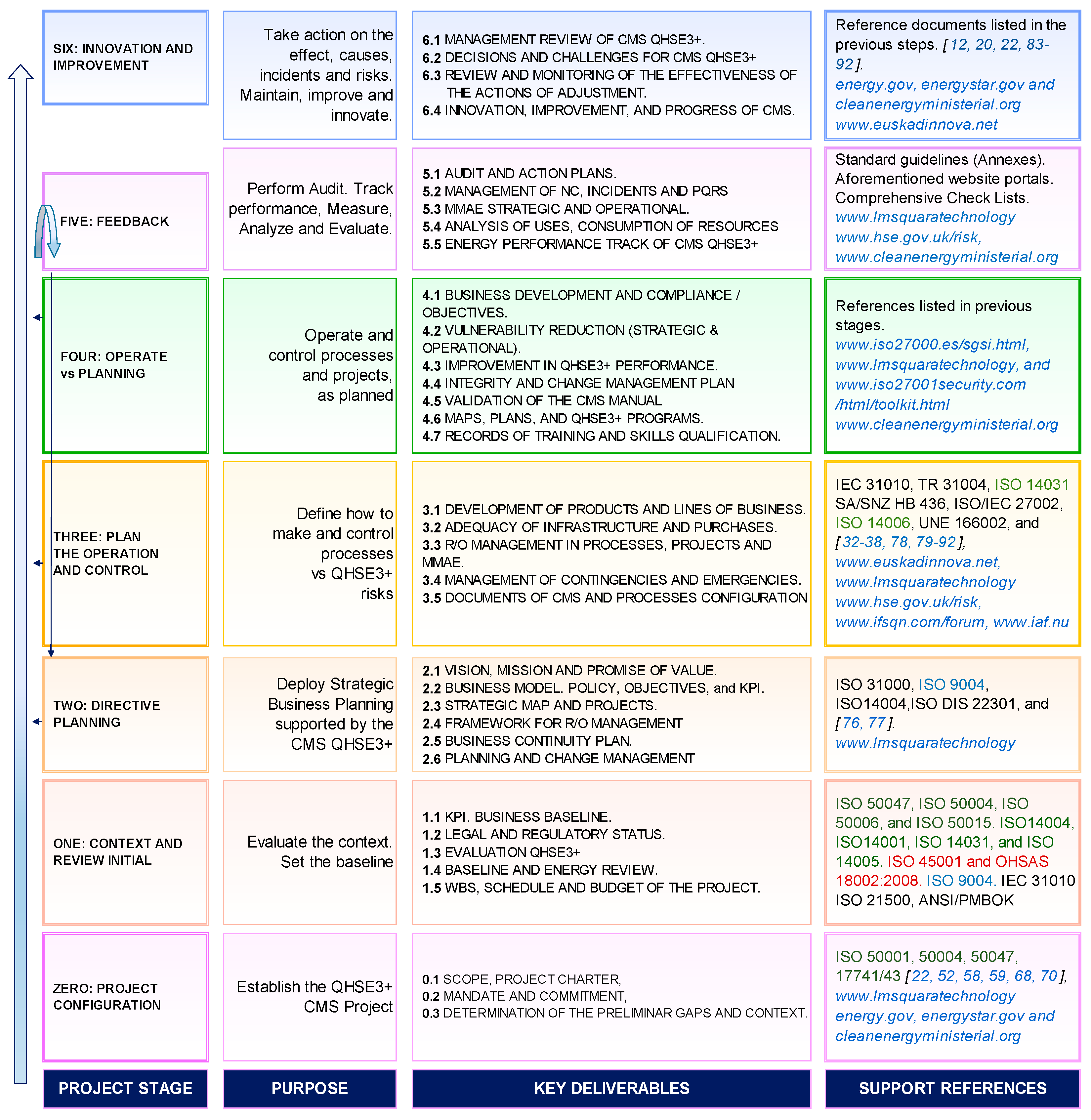
References
- ISO/TC 301 Energy Management and Energy Savings. Strategic Business Plan 2017. 2 October 2017. Available online: https://isotc.iso.org/livelink/livelink/fetch/2000/2122/687806/ISO_ TC_301_Energy_management_and_energy_saving.pdf?nodeid=19278553&vernum=-2 (accessed on 30 March 2019).
- Gasiorowski, E. Five years on—Did live up to its promise? ISO Focus 2017, 119, 14–19. [Google Scholar]
- ISO/IEC. Directives and Policies Ninth Edition, Part 2. Official Rules to Develop an ISO Standard. 2018. Available online: www.iso.org/directives-and-policies.html (accessed on 26 February 2019).
- ISO/TC 301 Energy Management and Energy Savings. Standards by ISO/TC 301. 2019. Available online: https://www.iso.org/committee/6077221.html (accessed on 30 August 2019).
- Clean Energy Ministerial CEM. CEM Advancing Clean Energy Together, Ministerial Meetings. 2019. Available online: https://www.cleanenergyministerial.org/events-Clean-Energy-Ministerial. CEM 01 to CEM 10 (accessed on 2 September 2019).
- Organization for Economic Co-Operation and Development OECD. 6 September 2018. Available online: https://stats.oecd.org/index.aspx?queryid=70734 (accessed on 30 August 2019).
- DG GROW. Strategic Plan 2016–2020. Bruxelles: CEE. 2017. Available online: https://trade.ec.europa.eu/doclib/docs/2016/august/tradoc_154919.pdf (accessed on 26 July 2019).
- Muñoz, P. The distinctive importance of sustainable entrepreneurship. CUOCIEnt 2013, 2, 1–6. [Google Scholar] [CrossRef] [Green Version]
- Parrish, B.D. Sustainability-driven entrepreneurship: Principles of organization design. J. Bus. Ventur. 2010, 25, 510–523. [Google Scholar] [CrossRef]
- The Standish Group. Chaos Report. 2015. Available online: http://www.laboratorioti.com /2016/05/16/informe-del-caos-2015-chaos-report-2015-bien-malfueron-los-proyectos-ano-2015/ (accessed on 20 September 2019).
- Arévalo, G. Cluster Support Programs in Latin America. Lessons Learned from the IDB Experience; Fourth Latin American Cluster Congress; CLAC TCI-Mendoza Government: Mendoza, Argentina, 2009; pp. 1–16. Available online: https://publications.iadb.org/es/publicacion/15838/programas-de-apoyo-clusters-en-america-latina-lecciones-aprendidas-de-la (accessed on 21 May 2019). (In Spanish)
- Uriarte, R.; Gil, M.; Valenzuela, J.; Ceballos, J. Methodology for the successful integration of an Energy Management System to an Operational Environmental System. Sustainability 2017, 9, 1304. [Google Scholar]
- Aven, T. Risk assessment and risk management: Review of recent advances on their foundation. EJOR 2016, 253, 1–13. [Google Scholar] [CrossRef] [Green Version]
- Oliva, F.L. A maturity model for enterprise risk management. Int. J. Prod. Econ. 2016, 173, 66–79. [Google Scholar] [CrossRef]
- Paraschivescu, A.O. Risk management and quality management an integrate aproach. ETC 2016, 19, 55–61. [Google Scholar]
- Thekdi, S.; Aven, T. An enhanced data-analytic framework for integrating risk management and performance management. Reliab. Eng. Syst. Safe 2016, 156, 277–287. [Google Scholar] [CrossRef]
- Dereinda, F.; Greenwood, L. Environmental Management System Risks and Oportunities: A Case Study in Pertamina Geothermal Energy Area Kamojang. In Proceedings of the World Geothermal Congress Pertamina, Melbourne, Australia, 19–25 April 2015; pp. 1–13. [Google Scholar]
- Krohn, B.; Aven, T. A new perspective on how to understand, asses and manage risk and the unforeseen. Reliab. Eng. Syst. Safe 2014, 121, 1–10. [Google Scholar]
- Wilson, J.; Campbell, L. ISO 9001:2015: The evolution and convergence of quality management and knowledge management for competitive advantage. Total Qual. Manag. Bus. 2018, 29, 1–16. [Google Scholar] [CrossRef]
- Ciravegna Martins da Fonseca, L. ISO 14001:2015: An improved tool for sustainability. JIEM 2015, 8, 37–50. [Google Scholar] [CrossRef] [Green Version]
- Cosgrove, J.; Littlewood, J.; Wilgeroth, P. Development of a framework of key performance indicators to identify reductions in energy consumption in a medical devices production facility. Int. J. Ambient Energy 2018, 39, 202–210. [Google Scholar] [CrossRef]
- Poveda, P.; Cañón, G. Guide for Integral Risk Management. Understand, Decide and Act Intelligently for Sustainable Success; ICONTEC: Bogotá, Colombia, 2015; ISBN 9789588585512. (In Spanish) [Google Scholar]
- Castrillón, R.; Rey, J.; Velasco, E.; San José, A.; Rey, F. Analysis of the Methodology to Obtain Several Key Indicators Performance (KIP), by Energy Retrofitting of the Actual Building to the District Heating Fuelled by Biomass, Focusing on nZEB Goal: Case of Study. Energies 2019, 12, 93. [Google Scholar] [CrossRef] [Green Version]
- Haeri, A. Proposing a quantitative approach to measure the success of energy management systems in accordance with ISO 50001: 2011 using an analytical hierarchy process (AHP). Energyequipsys 2017, 5, 349–355. [Google Scholar]
- Chiu, T.; Lo, S.; Tsai, Y. Establishing an integration-energy-practice model for improving energy performance indicators in ISO 50001 energy management systems. Energies 2012, 5, 5324–5339. [Google Scholar] [CrossRef] [Green Version]
- Laskurain, I.; Ibarloza, A.; Larrea, A.; Allur, E. Contribution to energy management of the main standards for environmental management systems: The case of ISO 14001 and EMAS. Energies 2017, 10, 1758. [Google Scholar] [CrossRef] [Green Version]
- Al-Sakkaf, S.; Kassas, M.; Khalid, M.; Abido, M. An energy management system for residential autonomous dc microgrid using optimized fuzzy logic controller considering economic dispatch. Energies 2019, 12, 1457. [Google Scholar] [CrossRef] [Green Version]
- Zobel, T.; Malmgren, C. Evaluating the Management System Approach for Industrial Energy Efficiency Improvements. Energies 2016, 9, 774. [Google Scholar] [CrossRef]
- Laskurain, I.; Heras, I.; Casadesús, M. Fostering renewable energy sources by standards for environmental and energy management. Renew. Sustain. Energy Rev. 2015, 50, 1148–1156. [Google Scholar] [CrossRef]
- Stoeglehner, G.; Niemetz, N.; Kettl, K. Spatial dimensions of sustainable energy systems: new visions for integrated spatial and energy planning. Energy Sustain. Soc. 2011, 1, 1–9. [Google Scholar] [CrossRef] [Green Version]
- Godet, M. The Art of Scenarios and Strategic Planning: Tools and Pitfalls. Technol. Soc. 2000, 65, 3–22. [Google Scholar]
- Calvillo, C.; Sánchez-Miralles, A.; Villar, J. Energy management and planning in smart cities. Renew. Sustain. Energy Rev. 2016, 55, 273–287. [Google Scholar] [CrossRef] [Green Version]
- Morvaj, B.; Lugaric, L.; Krajcar, S. Demonstrating Smart Buildings and Smart Grid Features in a Smart Energy City. In Proceedings of the 3rd International youth conference on energetics (IYCE), Leiria, Portugal, 7–9 July 2011; pp. 1–8. [Google Scholar]
- Blaauwbroek, N.; Nguyen, P.; Konsman, M.; Shi, H.; Kamphuis, R.; Kling, W. Decentralized Resource Allocation and Load Scheduling for Multicommodity Smart Energy Systems. IEEE Trans. Sustain. Energy 2015, 6, 1505–1514. [Google Scholar] [CrossRef] [Green Version]
- Mao, M.; Jin, P.; Hatziargyriou, N.; Chang, L. Multiagent-based hybrid energy management system for microgrids. IEEE Trans. Sustain. Energy 2014, 5, 938–946. [Google Scholar] [CrossRef]
- Carli, R.; Dotoli, M. Decentralized control for residential energy management of a smart users’ microgrid with renewable energy exchange. IEEE/CAA J. Autom. Sin. 2019, 6, 641–656. [Google Scholar] [CrossRef]
- Hosseini, S.; Carli, R.; Dotoli, M. Robust Day-Ahead Energy Scheduling of a Smart Residential User Under Uncertainty. In Proceedings of the 18th European Control Conference (ECC), Naples, Italy, 25–28 June 2019. [Google Scholar]
- Roy, S.; Goswami, S.; Pal, A.; Kumar, A.; Singh, H.; Biswas, M.; Ghosh, B.; Mandal, R. Application of Modified Particle Swarm Optimization Technique for Economic Scheduling of a Complex Micro Grid with Renewable Energy Sources. In Proceedings of the 2nd International Conference on Trends in Electronics and Informatics (ICOEI), Tirunelveli, India, 11–12 May 2018. [Google Scholar]
- ISEC LTD-ISO/IEC JTC1/SC 27. The ISO 27k Forum. 2018. Available online: https://www.iso27001 security.com/html/iso27000.html (accessed on 1 June 2019).
- IEC. IEC FDIS 31010:2010. Risk Assessment Techniques; IEC: Geneva, Switzerland, 2010. Available online: http://ehss.moe.gov.ir/getattachment/f7de1f2a-7559-49b5-8b97-c69b13fa17a9/31010-FDIS-(Risk-Assessment-Technics) (accessed on 2 September 2019).
- ISO. ISO 50004:2014: Guide for the Implementation, Maintenance and Improvement of an EnMS; ISO/IEC: Geneva, Switzerland, 2014. [Google Scholar]
- ISO. ISO 50006:2014: Measuring Energy Performance Using Energy Baselines (EnB) and Energy Performance Indicators (EnPI)—General Principles and Guidance; ISO/IEC: Geneva, Switzerland, 2014. [Google Scholar]
- International Organization for Standardization. ISO 50015:2014: Measurement and Verification of Energy Performance of Organizations—General Principles and Guidance; ISO/IEC: Geneva, Switzerland, 2014. [Google Scholar]
- ISO. ISO 31000:2018. Risk Management-Guidelines; ISO/IEC: Geneva, Switzerland, 2018. [Google Scholar]
- Poveda, P.; García-Díaz, J.; Hernandis, B. Application of the Systemic Method to the Design of a Conceptual Model for Comprehensive Management Systems QHSE3 + in SMEs. In IFDP’16—Systems and Design: Beyond Processes and Thinking. Electronic Book Proceedings; Universitat Politècnica de València: Valencia, Spain, 2016; pp. 651–664. (In Spanish) [Google Scholar]
- Cathalifaud, A.; Osorio, F. Introduction to the Basic Concepts of General Systems Theory. Cinta de Moebio. 1998. Available online: http://www.redalyc.org/articulo.oa?id=10100306 (accessed on 10 September 2019). (In Spanish).
- Von Bertalanffy, L. The theory of open systems in physics and biology. Science 1959, 111, 23–29. Available online: https://www.jstor.org/stable/1676073 (accessed on 10 September 2019). [CrossRef] [Green Version]
- Guerrero, M.; Hernandis, B. An approach to the representation of a product’s form and appearance: study on design attributes. Innovar 2018, 28, 25–39. [Google Scholar]
- Hernandis, B.; Iribarren, E. Systems Modeling New Products Design to Systemic Perspective; Universitat Politècnica de València: Valencia, Spain, 2011. [Google Scholar]
- Hernandis, B.; Briede, J. An educational application for a product design and engineering systems using integrated conceptual models. Ingeniare Rev. Chil. Ing. 2009, 17, 432–442. [Google Scholar] [CrossRef]
- Howard, T.; Culley, S.; Deconinck, E. Describing the creative design process by the integration of engineering design and cognitive psychology literature. Des. Stud. 2008, 29, 160–180. [Google Scholar] [CrossRef]
- Poveda, P.; García-Díaz, J.; Cañón, G. Conceptual Model and Route to Implement a Comprehensive Management System QHSE3+, in New Trends in Operations Research and Administrative Sciences. An Approach from Latin American Studies. 2017, pp. 115–164. Available online: https://bonga.unisimon.edu.co/handle/20.500.12442/2601 (accessed on 12 September 2019). (In Spanish).
- ISO. ISO 9001:2015, Quality Management Systems—Requirements; ISO/IEC: Geneva, Switzerland, 2015. [Google Scholar]
- ISO. ISO 45001:2018, Occupational Health and Safety Management Systems—Requirements; ISO/IEC: Geneva, Switzerland, 2018. [Google Scholar]
- ISO. ISO 14001:2015, Environmental Management Systems—Requirements with Guidance for Use; ISO/IEC: Geneva, Switzerland, 2015. [Google Scholar]
- ISO. ISO 50001:2018. Energy Management Systems—Requirements with Guidance for Use; ISO/IEC: Geneva, Switzerland, 2018. [Google Scholar]
- Ogutu, J.; Ben, M. Closing the gap: between traditional and enterprise risk management systems. Am. Soc. Saf. Eng. 2018, 63, 42–47. [Google Scholar]
- ISO. ISO 21500:2012, Guidance on Project Managemente; ISO/IEC: Geneva, Switzerland, 2018. [Google Scholar]
- Project Management Institute. A Guide to the Project Management Body of Knowledge; PMBOK Guide; PMI Inc.: Lemoyne, PA, USA, 2017. [Google Scholar]
- Golini, R.; Kalchschmidt, M.; Landoni, P. Adoption of project management practices: The impact on international development projects of non-governmental organizations. Int. J. Proj. Manag. 2015, 33, 650–663. [Google Scholar] [CrossRef]
- Marcelino, S.; González, L.; Pérez, A. Using project management as a way to sustainability: From a comprehensive review to a framework definition. J. Clean. Prod. 2015, 99, 1–16. [Google Scholar] [CrossRef]
- Archer, F.; Ghasemzadeh, F. An integrated framework for project portfolio selection. Int. J. Proj. Manag. 1999, 17, 207–216. [Google Scholar] [CrossRef]
- Velásquez, S.; Londoño, J.; López, C.; Vahos, J. A multimedia web platform development for project formulation under the logical framework methodology. Lámpsakos 2017, 18, 12–20. (In Spanish) [Google Scholar] [CrossRef]
- Sartorius, R. The logical frame work approach to project design and management. AJE 1991, 12, 139–147. [Google Scholar]
- Sánchez, N. The logical framework methodology for planning, monitoring and evaluation of projects. Visión Gerenc. 2018, 2, 332–343. (In Spanish) [Google Scholar]
- Crawford, P.; Bryce, P. Project monitoring and evaluation: A method for enhancing the efficiency and effectiveness of aid project implementation. Int. J. Proj. Manag. 2003, 21, 363–373. [Google Scholar] [CrossRef]
- Casas, G.; Scorza, F. Sustainable Planning: A Methodological Toolkit. In Proceedings of the 16th International Conference on Computational Science and Its Applications—ICCSA 2016, Beijing, China, 4–7 July 2016. [Google Scholar]
- Rosato, M. Go Small for Project Success. PMWJ 2018, 7, 1–10. [Google Scholar]
- San Cristóbal, J.; Carral, L.; Díaz, E.; Fraguela, J.; Iglesias, G. Complexity and project management: A general overview. Complexity 2018, 2018, 1–10. [Google Scholar] [CrossRef]
- Motoa, G. Measurement of project success, a review of the literature. Ingenium 2015, 9, 11–25. [Google Scholar]
- Ramasesh, R.; Browning, T. A conceptual framework for tackling knowable unknown unknowns in project management. J. Oper. Manag. 2014, 32, 190–204. [Google Scholar] [CrossRef]
- Pollack, J. The changing paradigms of project management. Int. J. Proj. Manag. 2007, 25, 266–274. [Google Scholar] [CrossRef] [Green Version]
- Fernández, V.; Vigil, J. Clusters and territorial development. Theoretical review and methodological challenges for Latin America. Econ. Soc. Y Territ. 2007, 6, 859–912. [Google Scholar]
- Lamers, M. Do you manage a project, or what? A reply to “Do you manage work, deliverables or resources”. Int. J. Proj. Manag. 2002, 20, 325–329. [Google Scholar] [CrossRef]
- Kaplan, R.; Norton, D. Translating Strategy into Action. In The Balance Scorecard; Harvard Business School Press: Boston, MA, USA, 1996; 322p, ISBN 0-87584-651-3. [Google Scholar]
- Suviri, J. Conceptualization and comparison of different models of corporate reputation assessment. Rev. Responsab. Soc. Empresa 2010, 4, 179–190. (In Spanish) [Google Scholar]
- Torabi, S.; Giahia, R.; Sahebjamniab, N. An enhanced risk assessment framework for business continuity management systems. Saf. Sci. 2016, 89, 201–218. [Google Scholar] [CrossRef]
- Gil, A.; Varela, G.; González, A. Practical Guide for the Implementation of the Standard UNE 166002: 2006 in Companies of the Residential Building Sector; Tekniker Foundation: Bilbao, Spain, 2008. (In Spanish) [Google Scholar]
- Baccarini, D. The Logical Framework Method for Defining Project Success. Proj. Manag. J. 1999, 30, 25–32. [Google Scholar] [CrossRef]
- Jin, K.; Sung, C. Electric energy consumption prediction by deep learning with state explainable autoencoder. Energies 2019, 12, 739. [Google Scholar]
- Girbau, F.; Díaz, F.; Sumper, A. Optimization of the operation of smart rural grids through a novel energy management system. Energies 2018, 11, 1–28. [Google Scholar]
- Nahida, M.; Mahmud, A.; Maung, A. A Hierarchical transactive energy management system for energy sharing in residential microgrids. Energies 2017, 10, 2098. [Google Scholar]
- Casals, M.; Gangolells, M.; Forcada, N.; Macarulla, M.; Giretti, A.; Vaccarini, M. SEAM4US: An intelligent energy management system for underground stations. Appl. Energy 2016, 166, 150–164. [Google Scholar] [CrossRef]
- Matrawy, K.; Mahrous, A.; Youssef, M. Energy management and parametric optimization of an integrated PV solar house. Energy Convers. Manag. 2015, 96, 373–383. [Google Scholar] [CrossRef]
- Kyriakarakos, G.; Dounis, A.I.; Arvanitis, K.G.; Papadakis, G. A Fuzzy logic energy management system for polygeneration microgrids. Renew. Energy 2012, 41, 315–327. [Google Scholar] [CrossRef]
- Johansson, M.T.; Thollander, P. A review of barriers to and driving forces for improved energy efficiency in Swedish industry—Recommendations for successful in-house energy management. Renew. Sustain. Energy Rev. 2018, 82, 618–628. [Google Scholar] [CrossRef]
- Jovanović, B.; Filipović, J. ISO 50001 standard-based energy management maturity model–proposal and validation in industry. J. Clean. Prod. 2016, 112, 2744–2755. [Google Scholar] [CrossRef]
- Majernik, M.; Bosak, M.; Stofova, L.; Szaryszova, P. Innovative model of integrated energy management in companies. Qual. Innov. Prosper. 2015, 19, 22–32. [Google Scholar] [CrossRef]
- Vermeeren, R.; Mulder, B.; Meta, B.; Reijnders, M. Implementation of ISO 50001 in Industry in The Netherlands. ECEE Industry Summer Study. 2012, pp. 679–688. Available online: www.eceee.org (accessed on 2 March 2019).
- Bunse, K.; Vodicka, M.; Schönsleben, P.; Brülhart, M.; Ernst, F.O. Integrating energy efficiency performance in production management–gap analysis between industrial needs and scientific literatura. J. Clean. Prod. 2011, 19, 667–679. [Google Scholar] [CrossRef]
- De Groot, H.; Verhoef, E.; Nijkamp, P. Energy savings by firms: Decision- making, barriers and policies. Energy Econ. 2001, 23, 717–740. [Google Scholar] [CrossRef] [Green Version]
- Cooremans, C. Investment in energy efficiency: Do the characteristics of investments matter? Energy Effic. 2012, 5, 497–518. [Google Scholar] [CrossRef] [Green Version]
- Schoenberger, H.; Canfora, P.; Dri, M.; Galvez-Martos, J.L.; Styles, D.; Antonopoulos, I. Development of the EMAS Sectoral Reference Documents on Best Environmental Management Practice. Learning from Frontrunners Promoting Best Practice. Publications Office of the European Union. 2014. Available online: https://publications.jrc.ec.europa.eu/repository/bitstream/JRC84966/lfna26291enn.pdf (accessed on 25 September 2019).


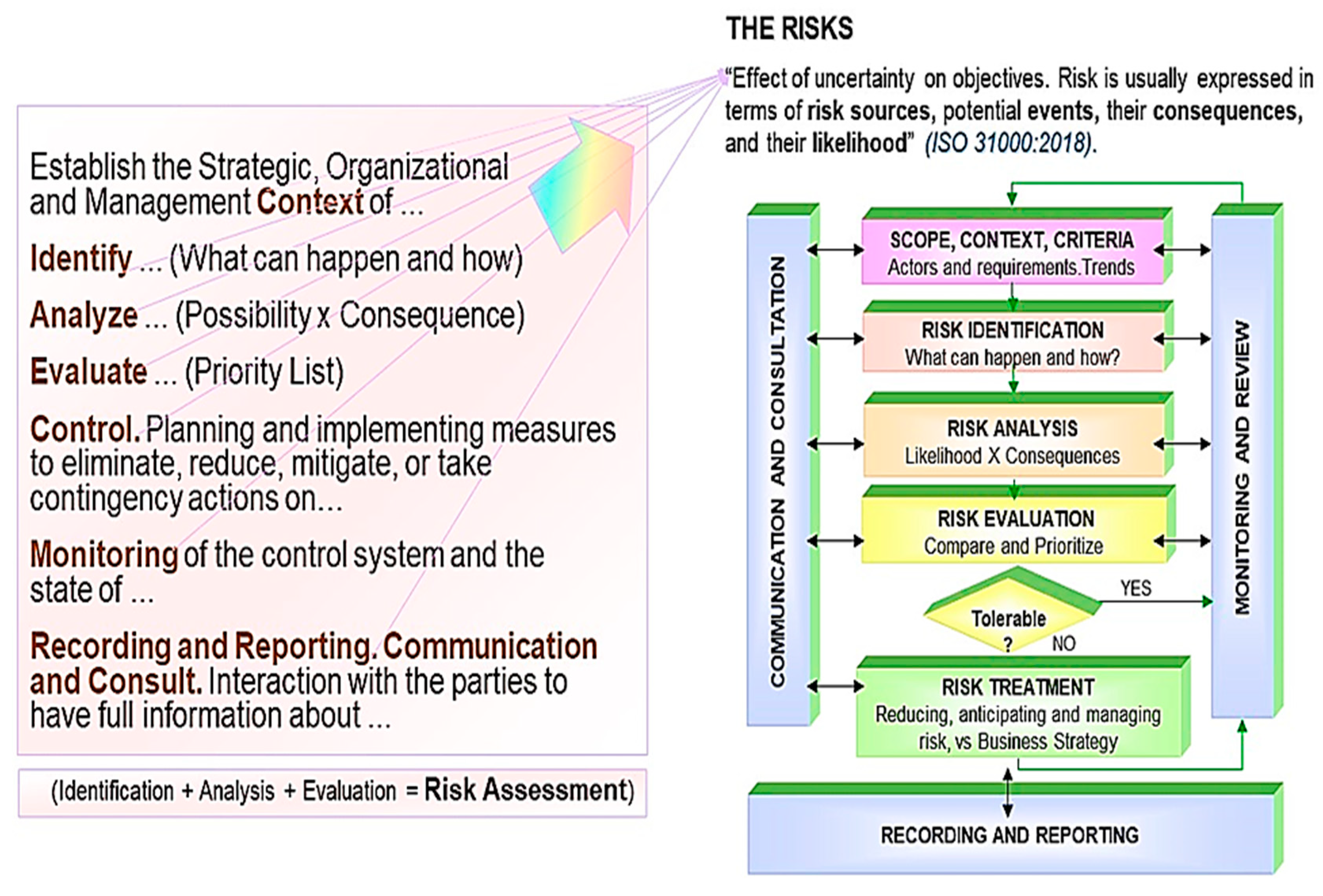



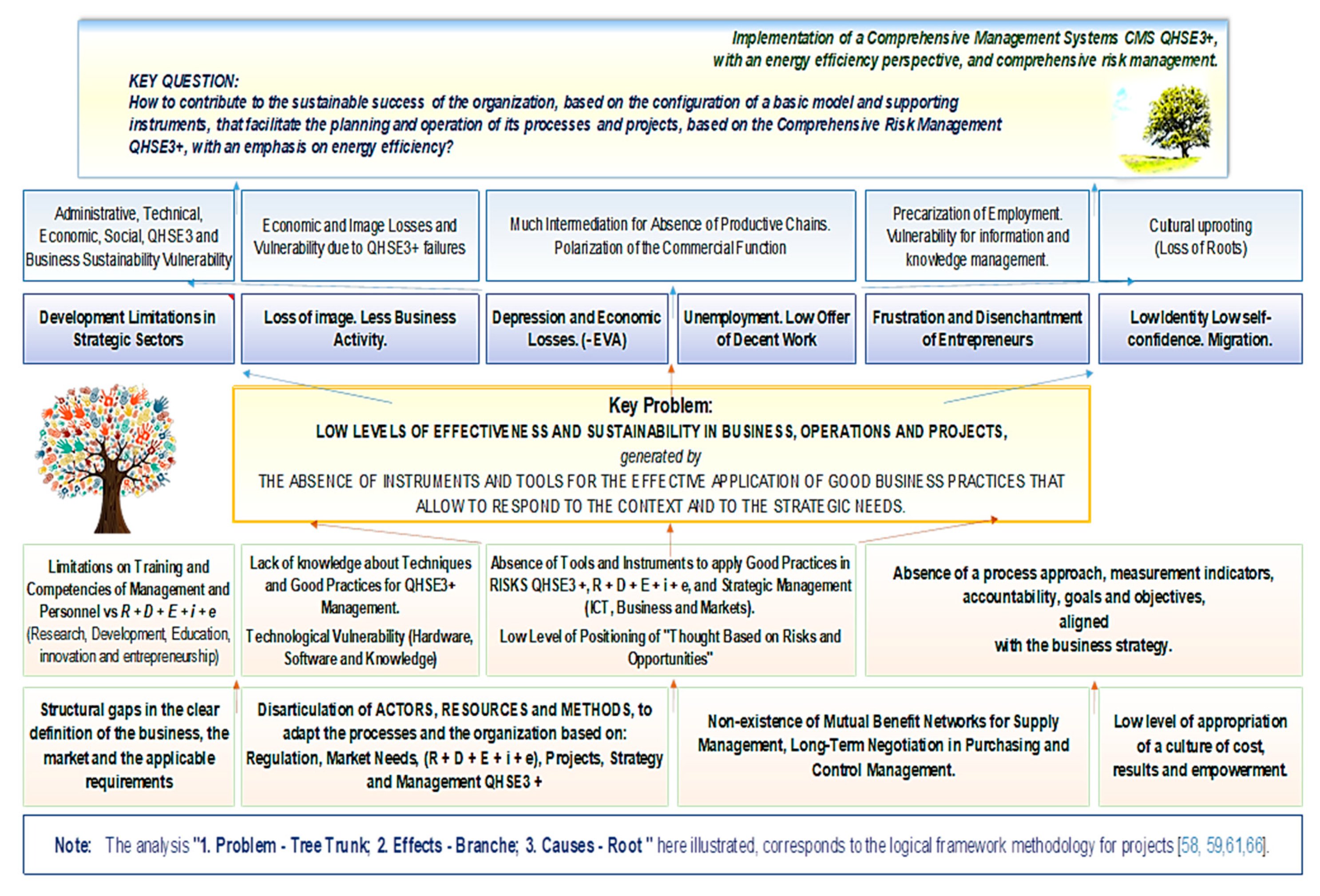
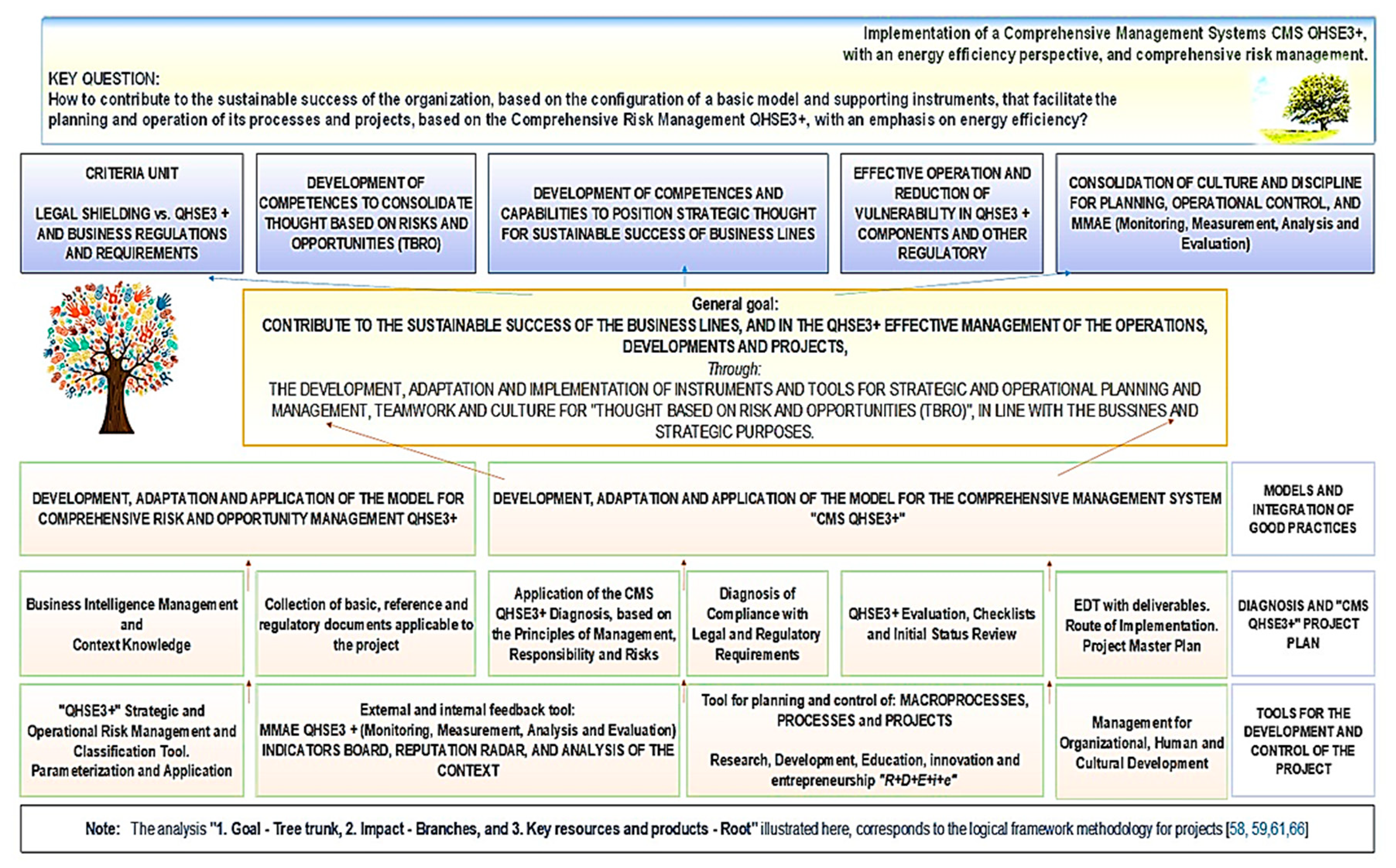




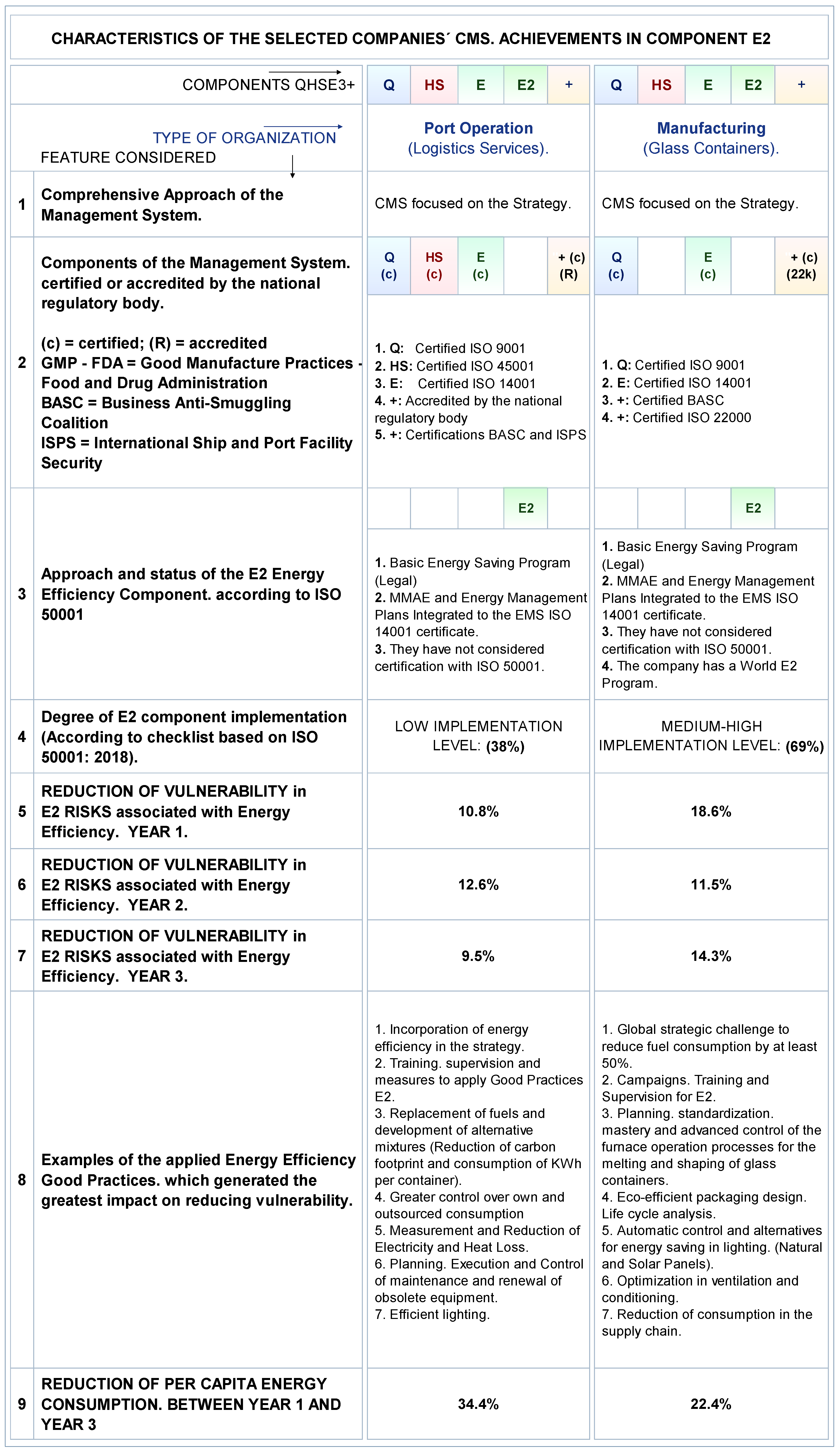
© 2019 by the authors. Licensee MDPI, Basel, Switzerland. This article is an open access article distributed under the terms and conditions of the Creative Commons Attribution (CC BY) license (http://creativecommons.org/licenses/by/4.0/).
Share and Cite
Poveda-Orjuela, P.P.; García-Díaz, J.C.; Pulido-Rojano, A.; Cañón-Zabala, G. ISO 50001: 2018 and Its Application in a Comprehensive Management System with an Energy-Performance Focus. Energies 2019, 12, 4700. https://doi.org/10.3390/en12244700
Poveda-Orjuela PP, García-Díaz JC, Pulido-Rojano A, Cañón-Zabala G. ISO 50001: 2018 and Its Application in a Comprehensive Management System with an Energy-Performance Focus. Energies. 2019; 12(24):4700. https://doi.org/10.3390/en12244700
Chicago/Turabian StylePoveda-Orjuela, P. Pablo, J. Carlos García-Díaz, Alexander Pulido-Rojano, and Germán Cañón-Zabala. 2019. "ISO 50001: 2018 and Its Application in a Comprehensive Management System with an Energy-Performance Focus" Energies 12, no. 24: 4700. https://doi.org/10.3390/en12244700
APA StylePoveda-Orjuela, P. P., García-Díaz, J. C., Pulido-Rojano, A., & Cañón-Zabala, G. (2019). ISO 50001: 2018 and Its Application in a Comprehensive Management System with an Energy-Performance Focus. Energies, 12(24), 4700. https://doi.org/10.3390/en12244700




